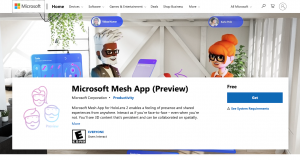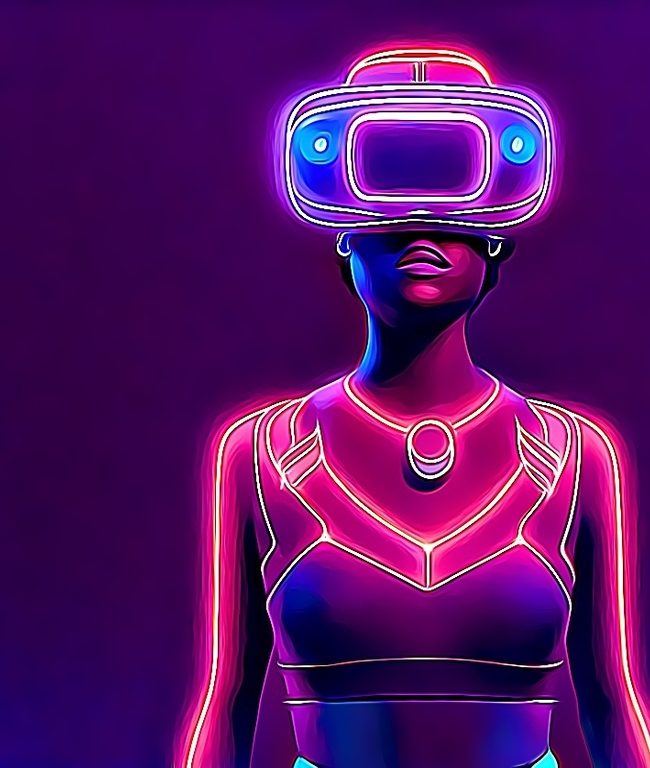
Who doesn’t know Microsoft?
Microsoft is probably one of the most well-known names in collaboration and communication these days. Microsoft Teams has gained popularity, offering everything from content sharing, and remote learning to video conferencing. It now takes its Apps to the Metaverse with Microsft Mesh.
The Teams platform is not the only example of Microsoft’s vision for an immersive and collaborative future. Microsoft has launched the mixed reality tool Mesh which aims to make collaboration a holographic experience. Microsoft Mesh is one of the latest additions to Microsoft’s mixed-reality projects.
According to futurists, the integration of real and virtual worlds through mixed reality can be imperative to improving teamwork and productivity. The pandemic has accelerated efforts by Microsoft to integrate the virtual world with the real world. Microsoft’s ecosystem allows Mesh to work with various VR/AR hardware
Microsoft Mesh provides both virtual and physical advantages. People can interact with each other in a secure environment within the holographic space. Collaborators can interact with each using virtual avatars, however, the ultimate goal of Microsoft Mesh is to provide holoportation technology.
Holoportation is a new 3D capture technology that reconstructs and transmits high-quality 3D models of people in real time. It seems straight out of a science fiction movie. But Microsoft is making it possible. Microsoft Mesh aims to make it easier for users to interact with others, regardless of where they are.
How Is Microsoft Gearing For The Metaverse?
Microsoft is gunning big. If you read through the recent investments of Microsoft, you’ll realize that it intends to create a pathway to the Metaverse.
In January 2022, the company announced plans to acquire Activision Blizzard, a video game developer and publisher for a $75 billion transaction. Games are the route that Microsoft intends to take as a prelude to the bigger game plan – the Metaverse.
This $75 billion investment is not just for their Xbox line-up but also for the future of the fabric of social interaction.
Microsoft not only announced plans to buy Activision Blizzard but has also bought Bethesda, one of the world’s biggest game studios in the world for $7.5 billion. The Activision Blizzard acquisition elevates Microsoft to the world’s third-largest gaming company in terms of revenue.
Experts in the gaming world view this as a strategic move by Microsoft, to consolidate its footing as a serious player in the Metaverse world.
‘The world’s largest tech companies are betting big on owning gamers’ attention and wallets, and each step represents an approach to the metaverse’s future,’- Mike Sepso, CEO of esports infrastructure platform Vindex.
Sepso further goes on to say- ‘There is a stark divide in focus between tech and media companies’ views on the assets they need to win the future.’
Many technology companies besides Microsoft are taking a dip in the Metaverse ocean. Facebook rebranded itself Meta as part of a revamp to focus on the Metaverse. Match Group, the parent company of Tinder will launch a virtual environment for dating.
Sports brands have joined the bandwagon with Nike purchasing a company that creates virtual sneakers for avatars. It’s playtime for kids with Lego and Epic games teaming up to shape experiences in the Metaverse.
What will be interesting to see is how Microsoft collaborates with marketers to provide immersive experiences in the Metaverse.
How Does A User Get Started With Mesh – Hardware, Software, And The Works?
Without sounding too technical, we’ll try and simplify the components of the Mesh Platform.
Hardware Of Microsoft Mesh
With Mesh, users can meet from where they are. Therefore, users can use different brands of devices. Mesh supports a range of head-mounted displays (HMDs) from fully immersive Head-Mounted Displays (HMDs) such as Microsoft HoloLens, HP Reverb G2, or Oculus Quest 2 for a 3D volumetric experience. Mesh also functions on iOS and Android phones, tablets, and PCs for convenience.
Software Of Microsoft Mesh
Microsoft endeavors to provide an expansive developer platform for Mesh.
Azure is at the heart of the developer platform. It brings duly authenticated and authorized users into a secure and trusted session using identity services such as Azure Active Directory. With Microsoft Graph APIs, developers can build apps that support Microsoft 36 to access people-centric data and insights.
AI is an important piece in the tech stack of Mesh. Microsoft has AI-powered capabilities that enable Mesh to address challenges with Massive Multiuser Online (MMO) scenarios for mixed reality. The AI-powered capabilities of Mesh include –
Avatars that represent users; the Mesh platform is equipped with an avatar rig and a customization studio.
Mesh facilitates photorealistic holoportation – a 3D capture technology to beam a lifelike image of a user into a virtual environment.
Spatial Maps place holograms that are stable across devices, time, and space.
Holographic rendering that supports rendering in Mesh-driven apps. Rendering could be either cloud-based remote rendering or local stand-alone rendering.

Read to know more about the technological capabilities of the Microsoft Mesh platform.
Get started With Microsoft Mesh
As a user, you can get started by –

Downloading the Microsoft Mesh App from the Microsoft Store and installing it on your device.
Launch Microsoft Mesh on your HMD from the pins panel.
Sign in using your personal Microsoft account, and start using the Mesh App.
In case you’re stuck somewhere, refer to this document from Microsoft.
How Can Companies Benefit From Microsoft Mesh?
Microsoft Mesh’s purpose is to enable users in different locations to collaborate through holographic experiences with the productivity tools of Microsoft Teams.
Remote collaborators will be able to interact with shared tools, allowing users to do more than just make suggestions. Microsoft has added drop-in spaces to Mesh so company employees can interact informally, similar to how one might bump into someone in the hallway or canteen.
There are industry scenarios where Mesh could be an advantage. Engineers can design machinery, automobiles, and products with the help of holographic modeling. Similarly, architects can walk through buildings in the virtual world. Other application areas for Mesh are medical research, marine exploration, and education. This is just the tip of the iceberg.
It would have been amazing if we could have conversations over coffee (in our virtual office) with colleagues using our avatars (in the safety of our homes) during the pandemic.




